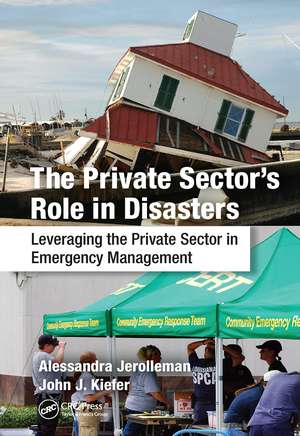The Private Sector's Role in Disasters: Leveraging the Private Sector in Emergency Management
Editat de Alessandra Jerolleman, Ph.D. Kieferen Limba Engleză Paperback – 13 dec 2021
The private sector now plays a tremendous role in the creation of policies related to emergency management and their implementation at the federal, state, and local levels. The Private Sector’s Role in Disasters: Leveraging the Private Sector in Emergency Management explores some of the challenges of implementing policies in the current contracting model. It also compares emergency management to other government services that have been privatized. Case studies of recent disasters and examples of the privatization of some emergency management functions are presented to illustrate how to better plan for private sector involvement in future disasters.
Given the sometimes dysfunctional relationships that have emerged from public–private partnerships in disaster situations, it is important to analyze and improve principles and practices to work toward more effective partnership. This book provides thoughtful guidelines, recommendations, and best-practice approaches to public–private development, implementation, and collaboration throughout the disaster cycle. It gives focused directions for cultivating public–private working relationships to make emergency responses quicker and assistance more effective.
| Toate formatele și edițiile | Preț | Express |
|---|---|---|
| Paperback (1) | 324.61 lei 6-8 săpt. | |
| Taylor & Francis – 13 dec 2021 | 324.61 lei 6-8 săpt. | |
| Hardback (1) | 1006.60 lei 6-8 săpt. | |
| Taylor & Francis – 5 oct 2015 | 1006.60 lei 6-8 săpt. |
Preț: 324.61 lei
Nou
Puncte Express: 487
Preț estimativ în valută:
62.11€ • 64.08$ • 51.83£
62.11€ • 64.08$ • 51.83£
Carte tipărită la comandă
Livrare economică 26 martie-09 aprilie
Preluare comenzi: 021 569.72.76
Specificații
ISBN-13: 9781032242675
ISBN-10: 1032242671
Pagini: 342
Ilustrații: 32 Illustrations, black and white
Dimensiuni: 156 x 234 x 18 mm
Greutate: 0.49 kg
Ediția:1
Editura: Taylor & Francis
Colecția CRC Press
Locul publicării:Oxford, United Kingdom
ISBN-10: 1032242671
Pagini: 342
Ilustrații: 32 Illustrations, black and white
Dimensiuni: 156 x 234 x 18 mm
Greutate: 0.49 kg
Ediția:1
Editura: Taylor & Francis
Colecția CRC Press
Locul publicării:Oxford, United Kingdom
Public țintă
Professional Practice & DevelopmentCuprins
Recent Trends in Emergency Management. Privatization of Some Emergency Management Functions: Recent Disasters and Case Examples. A Primer on Federal and State Disaster Funds and Funding. Privatization of Disaster Preparedness: Increasing Resilience through Planning. Private Sector’s Role in Emergency Response. Recovery and Rebuilding with the Private and Public Sectors. Hazard Mitigation. Homeland Security and the Private Sector in Emergency Management Prevention. Nonprofits, Academic Institutions, and Their Role in the Disaster Management Cycle. Continuity of Operations and Business Continuity.
Notă biografică
Alessandra Jerolleman is vice president of Louisiana Water Works and is also a senior emergency management and hazard mitigation planner for JEO Consulting Group Inc. She currently teaches at Tulane University and Jacksonville State University. She has served as a program specialist in the Gulf Coast with Save the Children USA and worked on a resilience initiative around children’s needs in emergencies. She has also participated in hazard mitigation planning at the local, state, and campus levels, in community education and outreach regarding mitigation measures and preparedness, in developing collaborative networks and information sharing avenues among practitioners; and in training and educating various stakeholders. Dr. Jerolleman is one of the founders of the Natural Hazard Mitigation Association (NHMA) and served as its executive director for its first seven years. She is involved in various aspects of planning and policy at the national and local level, including participation in several workshops each year. She also speaks on many topics, including: hazard mitigation and climate change; campus planning; threat, hazard and vulnerability assessments; hazard mitigation planning; protecting children in disasters; and public–private partnerships.
John J. Kiefer is a professor and director of the MPA program at the Department of Political Science at the University of New Orleans (UNO). He is also a faculty associate at the Center for Hazards Assessment, Response and Technology (CHART), UNO’s applied hazards social science research center. He is currently either principal investigator or a research team member for several projects and is on the Executive Board of the Southeastern Conference for Public Administration. He has also delivered numerous papers and chaired panels at professional meetings in the United States and Canada. His current research interests include hazard policy, emergency management, and program evaluation, and he specializes in the development of outcome-focused collaborative networks to create disaster resilience, especially in vulnerable populations.
John J. Kiefer is a professor and director of the MPA program at the Department of Political Science at the University of New Orleans (UNO). He is also a faculty associate at the Center for Hazards Assessment, Response and Technology (CHART), UNO’s applied hazards social science research center. He is currently either principal investigator or a research team member for several projects and is on the Executive Board of the Southeastern Conference for Public Administration. He has also delivered numerous papers and chaired panels at professional meetings in the United States and Canada. His current research interests include hazard policy, emergency management, and program evaluation, and he specializes in the development of outcome-focused collaborative networks to create disaster resilience, especially in vulnerable populations.
Descriere
This book examines the role of the private sector in emergency management and how that role is changing through private sector intersections with government, government agencies, and the public sectors in all phases of emergency management. It particularly focuses on the areas in which government regulations and guidelines promote or encourage p

















